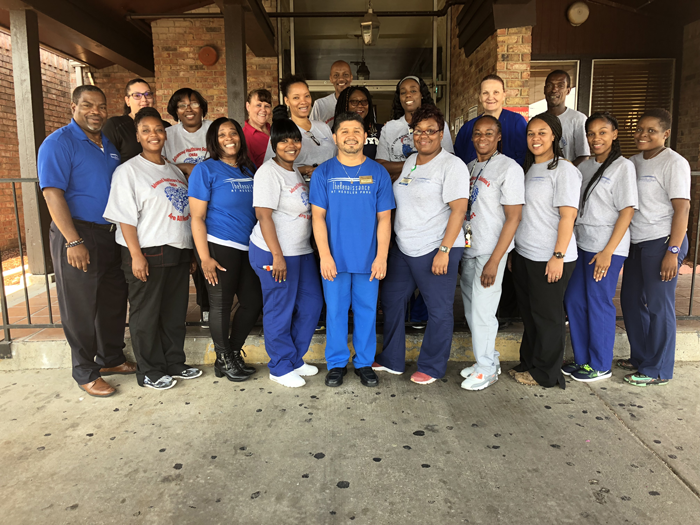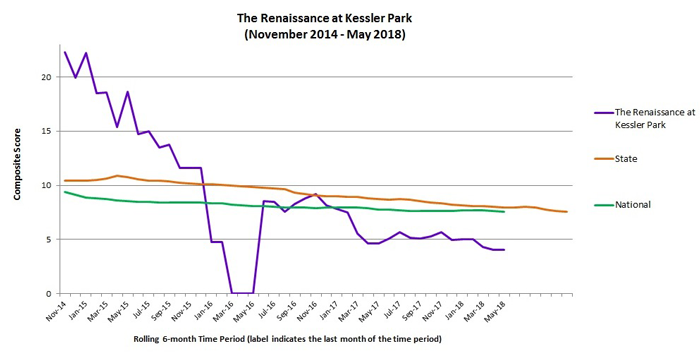In October 2015, The Renaissance at Kessler Park, a 135-bed skilled nursing facility in Dallas, had a composite score of 15.11. Determined to improve that score, The Renaissance staff worked with TMF Health Quality Institute, the Quality Innovation Network Quality Improvement Organization (QIN-QIO), under contract with the Centers for Medicare & Medicaid Services, to create an action plan for success.

The team at The Renaissance at Kessler Park
“We started by learning the basics of how the TMF QIN-QIO works with our facility and the overall process of quality improvement, such as how the data was gathered, the Quality Improvement and Evaluation Service benchmarks, which are more commonly known as QIES, how to put it all together and make it learnable for us, as well as how to teach it to our team. We needed to be able to make it feasible,” said Renetta Johnson, director of nursing (DON) at The Renaissance.
Johnson began by assigning a quality measure (QM) to a nurse manager and team that was above the state average. Together with the manager heading that team, Johnson and the administrator ensured the quality improvement process was followed and the data was recorded correctly. Once a week the different teams met and discussed the QM and the residents who triggered, why they triggered and how they could look at similar residents with Minimum Data Sets (MDS) assessments coming up to ensure that they could improve the quality of life and care delivered.
“We pulled all data related to the residents triggering and those who were 21 days out from having a MDS,” Johnson explained. “We looked at each one of them and performed a root cause analysis. Sometimes the root cause was different for each resident, depending on the QM, so we found we might have several root causes.”
Johnson’s team put together an action plan following the Plan-Do-Study-Act (PDSA) model for improvement.
“We found we needed to update the plan as things sometimes worked and others did not,” said Johnson. “So we learned to work through the PDSA cycle and go back to make changes as needed until we got a plan that was sustainable for each resident, as well as the overarching system we were focusing on based on each QM.”
One of the biggest challenges that The Renaissance team had to work through was staff turnover. The facility addressed this by teaching the QMs, MDS and methodology during new staff orientation. They added in-service trainings to bring the entire staff up to speed. But that alone was not enough.
“We also hosted a QM fair during Nurses Week, and the team leaders held in-service quarterly meetings as well anytime changes are made to the action plan,” Johnson said. “Each manager went around the facility training the staff about their QM focus and giving out treats if staff members knew the correct answers to questions.”
In addition, The Renaissance team made posters about quality improvement work and gave handouts to recruit staff to join the various QM teams.
“We also put information about the TMF QIN-QIO and quality improvement into our overall new hire in-service,” Johnson said. “Each manager comes in and presents their QM in a way that they think will get the new staff’s attention.”
For example, the assistant DON, Shadonna Archie, is head of the Falls team. During new-hire orientation she presents her Falls QM, explains how they started, how she learned about the QM and how to alert the team when a resident is a fall risk. An orange star is placed outside the resident’s door, an orange band goes on the resident’s walker or wheelchair and an alert is placed on the certified nurse assistant’s assignment sheet.
“We show them these items during orientation, not by just talking to the team member, because actions speak louder than words,” Johnson added.
Monthly TMF QIN-QIO calls were also a key to success. The manager for each focus QM would present to TMF Quality Improvement Consultant Melody Malone, PT, CPHQ, MHA, CDP, CADDCT, about the work they were doing. In this way, neither the DON nor the administrator was the only one sharing successes and challenges. It also meant the managers had to know the QM and the quality improvement process for their system.
“The TMF QIN-QIO calls were very informative,” said Johnson. “They helped us learn all about the QMs because there were several facilities on these calls. We learned from them as they shared their quality improvement experiences and brought forth questions about a QM they were working on. Melody was a lifesaver with the monthly calls and her understanding of the material was great. Her overall view and looking from the outside in gave us more ideas on how to work with the information. The TMF QIN-QIO website was also a great resource in learning the material. By using the TMF QIN-QIO video series on QMs and the QAPI video series, we were able to learn the measure specifications quickly, which also helped us with our root cause analysis.”
As The Renaissance began to see its numbers improve, the staff got excited and patients began to experience a better quality of life. The facility began to get corporate recognition for its achievements. By April 2018, the facility’s composite score had dropped to 4.04.

This line graph shows how the facility improved its score to 4.04 by April 2018.
“We celebrated as our five-star rating began to rise and our composite score began to fall. As we continue to work on QMs and quality improvement as a whole in our facility, our care plans are more informative, our care at the bedside is getting better and we look forward every month in pulling our numbers to see how far we’ve come,” Johnson said.
“I’m so proud of team Renaissance,” David Roberts, administrator of The Renaissance said. “The lessons we have learned from participating in the TMF QIN-QIO program have been invaluable. We are a better team today, because we worked really closely with each other trying to solve different issues. Not only did our staff benefit, but the residents and families benefited as well. I truly believe one of the reasons we are a five-star facility is because we participated in the TMF QIN-QIO program.”
For more information about The Renaissance, please email Renetta Johnson, DON, at The Renaissance RJohnson@renaissanceatkesslerpark.com.
For more information about the TMF QIN-QIO Nursing Home Quality Improvement Learning and Action Network, please visit www.tmfnetworks.org or email nhnetwork@tmf.org.
View the TMF QIN-QIO Nursing Home team’s video series
Quality Measures Video Series
Quality Assurance and Performance Improvement (QAPI) Video Series
This material was developed by TMF Health Quality Institute, the Medicare Quality Innovation Network Quality Improvement Organization, under contract with the Centers for Medicare & Medicaid Services (CMS), an agency of the U.S. Department of Health and Human Services. This content does not necessarily reflect CMS policy. 11SOW-QINQIO-C2-18-56 Published 8/2018